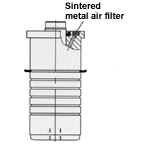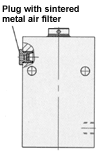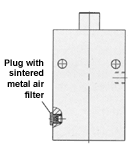Single-Acting Clamps
without Vent Port

Single-Acting Clamps
with Vent Port

Work Supports

Components that Require Venting when Using Flood Coolant
Due to increased use of coolants and cutting fluids in metal-cutting machining, there is also an increased danger that some very aggressive fluids penetrate into the spring areas of single-acting clamping elements and work supports, causing malfunctions.
It is important to realize these problems during the design stage.
Why is Venting Required?
Double-acting clamps are better suited for machining applications using flood coolant. Unlike double-acting clamps, which have hydraulic fluid on both sides of the piston, single-acting clamps have a small air chamber for the spring on one side of the piston. This air exhausted during the clamping stroke, then new air is sucked in during the unclamping stroke. The use of coolants and cutting fluids has to be considered in the fixture design. Although all single-acting clamps have sintered-metal air filters to prevent contaminants from entering, there is still a chance that aggressive fluids can enter the spring area (especially with flood coolant), eventually causing malfunctions.
If components are not properly vented, this can lead to excess pressure or vacuum in the spring area, changing the spring forces, which leads to malfunctions. Formation of condensation water promotes rust formation and can lead to eventual failure of the component. Liquid accumulating in the spring area is perhaps the worst problem, because it can cause significant excess pressure or vacuum, leading to immediate malfunctions.
Solution 1: Protective Covers
Clamping elements without a vent port can be covered, but due to the typical quantities of coolant used nowadays, this approach is sometimes unsuccessful. In such applications you should consider double-acting elements.
Solution 2: Air-Vent Lines
Replace the air-vent filter plug with an air-vent fitting, then connect a vent hose or tube if the open end can be displaced to a point where no liquid can penetrate. This method works well. Finding a dry area is not always easy on a machining-center pallet flooded in coolant.
Solution 3: Closed Air-Vent System
The spring area can be increased by the connection of an additional area so that only a little excess pressure or depression will be generated so that neither the functioning of the elements will be influenced nor liquids will be drawn off. Waterproof electrical boxes provided with connecting threads for bleeding hoses are ideal for the job. The volume of this "additional area" should be ten times the stroke volume of all connected elements.